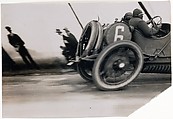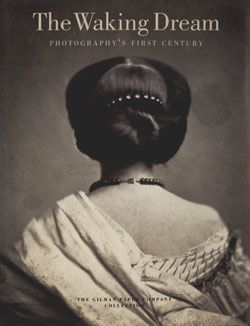Le Grand Prix A.C.F.
Jacques-Henri Lartigue French
Not on view
A painter who considered photography a hobby, Jacques-Henri Lartigue grew up in the privileged environment of an attentive well-to-do family and was seven years old when his father, himself an accomplished amateur photographer, presented him with his first camera. From the start, the process of making pictures held for Lartigue an essential element of play. In it the boy saw a magical way of storing and intensifying the most pleasurable of his visual experiences, fashioning the snapshot into a perfect tool to capture the fun and excitement of his daily life: the reckless jumps and bicycle falls of his cousin Bichonnade, or the hairpin turns of racing bobsleds, and the mishaps of huge gliders built by his inventive older brother, the daredevil Zissou. Later, as a timid adolescent, he went on to capture, with the same humor, the brisk walk and knowing smiles of the elegant ladies parading in fantastic hats on the avenues of the Bois, or at the racetrack. And all along, as he grew up, he would be fascinated by the fast progress and changing shapes of the automobile, and by the soaring flight of the airplane.
Preserving his images from childhood on in album after album, Lartigue created an inordinately rich chronicle, but one that, like his diaries, remained essentially private. Until 1963, when a show at the Museum of Modern Art in New York revealed Lartigue as a major photographer, his work was known only to a group of friends. Now, however, the images of Lartigue's childhood are widely known; indissolubly associated with the Belle Epoque, that confident, prosperous, carefree childhood of the century, they have become emblematic of its optimistic energy and vanished grace.
Lartigue loved everything about cars--their intriguing look, the accoutrements of the driver, the eventual flat tire. The 1913 Grand Prix of the Automobile Club de France is among the photographer's most memorable images; this print is a rarity, having been made by Lartigue prior to his public recognition, in his customary intimate scale.
The Grand Prix was run in 1913 on the circuit of Dieppe, and while No. 6, a Schneider driven by a M. Croquet, was a favorite, it was actually the Peugeot, with the ace driver Georges Boillot at the wheel, that won, at speeds reaching over one hundred miles an hour. Swinging his camera parallel to the road in a movement that followed the car, Lartigue barely managed to catch the speeding machine in his frame. Sweeping trees and spectators in its wake, the car rushes onward with the single-minded urgency of the new age.
Due to rights restrictions, this image cannot be enlarged, viewed at full screen, or downloaded.


